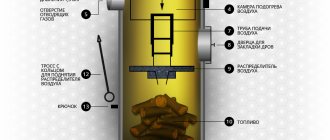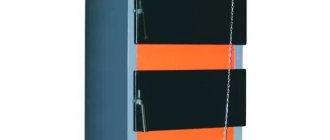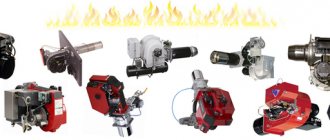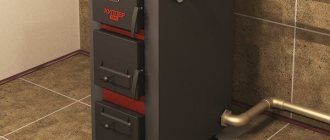Which is better, a gas or electric heating boiler, depends on the conditions of its use and the requirements put forward. From an economic point of view, if there is a central gas supply, it is more profitable to use a gas boiler, but it costs more than a similar electric boiler. Other factors also influence the final choice:
- complexity and cost of installation work;
- Equipment efficiency and functionality;
- features of its operation;
- requirements for document preparation;
- features of connecting boilers using different types of fuel;
- energy tariffs in your region;
- service life and operating comfort of the heating unit.
The comparison must be made taking into account all the criteria that are significant to you.
| Rated power, kW | 12 |
| Rated voltage, V | 380 |
| Outlet water temperature, C | 35-85 |
| Overall dimensions (mm) no more | 240 *140* 710 |
| Weight, kg no more | 11,3 |
| The area of heated premises at a design temperature of 25C and a room height of no more than 3 meters | 120-130 |
| frequency Hz | 50 |
| Pipe thread diameter | 1 1/4 inches (DN 32 mm.) |
| A heating element | SEV-12 |
Which machine should I install at 6 kilowatts? Electrics from A to Z
Current ratings of circuit breakers table Cross-section of copper conductors of the cable, sq. mm Permissible continuous current, A Rated current of the circuit breaker, A2.525164352564232105540 1 more line
Expert opinion
It-Technology, Electrical power and electronics specialist
Ask questions to the “Specialist for modernization of energy generation systems”
Electric heating boiler ElectroVel-12 kW automatic (380W) If you cannot find out for sure the voltage for which your electric boiler is designed and the connection diagram for its heating element, but you really need to connect it, I advise you to use the Star circuit. Ask, I'm in touch!
Differences in operating principle and characteristics
Electric boilers operate on the principle of direct heating of the coolant. They include a heating element, a toggle switch with temperature settings and automation. During installation, a grounding loop is connected to the equipment and a protective shutdown is provided.
The table shows a comparison of heating units according to the main criteria depending on the type of fuel used.
For stable operation of the equipment, clearly configured automation is required, connected to shut-off and control valves. At the slightest violation in the settings, the heating system refuses to start.
Control is provided by sensors, and safety is provided by automatic devices, grounding and installation of an RCD.
What kind of lighting do you prefer?
Built-in Chandelier
Regular washing of heat exchangers - at least once every 2 years.
Types of automation for heating boilers
The automation works properly, accurately and reliably, increases the efficiency of heating equipment, promotes reasonable consumption of energy resources and makes the operation of the heating system simple, comfortable and absolutely safe.
The automatic system protects heating installations from overloads and activates an emergency shutdown of the gas supply in the event of sudden force majeure circumstances. Additionally, the equipment regulates the level of combustion intensity and current fuel consumption, allowing owners to save money on heating the premises.
Based on the basic operating principle and design features, automation for gas-powered equipment is divided into:
- energy dependent devices;
- energy-independent devices.
Systems of the first type are complex electronic units that require an uninterrupted electrical supply to operate correctly. The second types of devices are simplified mechanical structures that do not require energy supply.
Type #1 - volatile products
A volatile module is a small electronic device that responds to the supply of a fuel resource. It turns on and off when the main gas valve is activated or closed. It has a complex design and a large number of elements and microcircuits.
Allows owners to solve the following tasks:
- activation or termination of gas supply;
- starting the heating system in automatic mode;
- adjusting the power level of the base burner (due to the presence of a thermostat);
- turning off a running boiler both in emergency situations and within a user-specified mode;
- displaying current indicators on the display (the general level of air temperature in the room, the point to which the working coolant has been heated, etc.).
More sophisticated modules have additional functionality and offer users unlimited and most convenient conditions for monitoring the operation and control of the unit. Electronic panels provide full protection of heating equipment from malfunction of the three-way valve and prevent the boiler from freezing.
What is the cable cross-section for 15 kW?
For open introduction at a voltage of 380 V and a power of 15 kW, a copper conductor with a cross-section of 4 mm² and capable of withstanding a current of 41 A is required, and for an aluminum wire - from 10 mm² and a current of 60 A. For those laid in a pipe For cables, copper conductors must have a cross-section of 10 mm², and for aluminum cables – from 16 mm².
- To calculate the power rating of a three-phase machine, it is necessary to sum up the entire power of electrical appliances that will be connected through it. ...
- L1 5000 W + L2 5000 kW + L3 5000W = 15000 W.
- We convert the resulting watts into kilowatts:
- 15000 W / 1000 = 15 kW.
- We multiply the resulting number by 1.52 and get the operating current A.
Connecting an electric boiler to electricity | Electrical wiring calculation –
For example, the power is 7.2 kW, calculated using the formula 7200/220 = 32.72 A. The table shows ratings of 16, 20, 32, 25 and 40 A. The value is 32.72 A, taking into account the operation of the device at a value of 1 ,13 times more than the nominal value, multiply: 32x1.13=36.1 A. The table shows that it is better to install a 40 A model.
Expert opinion
It-Technology, Electrical power and electronics specialist
Ask questions to the “Specialist for modernization of energy generation systems”
Which machine should I install for 5 kilowatts? Your online encyclopedia The current leakage of a private house is about 350 mA, a separate group of devices is 30 mA, lamps and sockets are 30 mA, single links are 15 mA, a boiler is 10 mA. Ask, I'm in touch!
What are the tariffs for rural areas and for the city?
To a large extent, electricity tariffs depend on the area in which the consumer lives (city or rural area). Thus, the tariff in rural areas will be 30% cheaper than in urban areas.
This point has its own nuances, namely: the reduced (preferential) tariff applies only in rural settlements. Whereas, in the case when a village, both dacha and cottage (for example: DNT, SNT, etc.) does not have the status of a rural municipality (is not located within the boundaries of a rural settlement), then residents will have to pay for electricity at the rates provided for the city. The same rule fully applies to urban settlements (urban-type settlements). Although the standard of living in them, as well as their amenities, does not differ significantly from villages and villages, residents of such urban settlements must pay for consumed electricity at the tariffs provided for the city.
In addition to the above information, we invite readers to watch a video that will tell you exactly how to calculate the cost of 1 kW of electricity and what this amount consists of.
In conclusion, it should be noted that electricity bills should be paid on time and at the tariffs that are provided in a particular region. Only in this case will subscribers not have any problems with regulatory authorities.
Operating principle and purpose of the circuit breaker
The three-phase circuit breaker is activated in case of a line fault using an electromagnetic switch. The principle of operation of the element is to heat the bimetallic plate at the moment the current rating increases and the voltage is turned off.
The fuse prevents short circuits and overcurrents with values higher than the calculated values from affecting the wiring. Without it, the cable cores heat up to the melting point, which leads to the ignition of the insulating layer. For this reason, it is important to know whether the network can handle the voltage.
Correspondence of wires to load
The problem is typical for old buildings, in which new machines, a meter, and an RCD are installed on the existing line. The machines are selected according to the overall power of the equipment, but sometimes they do not work - the cable smokes or burns.
For example, the cores of an old cable with a cross-section of 1.5 mm2 have a current limit of 19 A. If equipment with a total current of 22.7 A is turned on at a time, only a 25 Ampere modification will provide protection.
The wires will heat up, but the switch will remain turned on until the insulation melts. A fire can be prevented by completely replacing the wiring with a copper cable with a cross-section of 2.5 mm2.
Protecting the weakest section of cable wiring
Based on clause 3.1.4 of the PUE, the task of the automatic device is to prevent overload on the weakest link of the electrical circuit. Its rated current is selected based on the current of the connected household appliances.
If the machine is selected incorrectly, the unprotected area will cause a fire.
Expert opinion
It-Technology, Electrical power and electronics specialist
Ask questions to the “Specialist for modernization of energy generation systems”
Cable for an electric boiler - which is better, calculation of the cross-section To do this, we will use the data from the article Diagram for connecting an electric boiler to the electrical network, which shows in detail all the main diagrams for connecting any electric boilers to electricity, and in addition, recommendations are given on the choice of cable cross-section and circuit breaker. Ask, I'm in touch!
How to choose a circuit breaker and wire for an electric boiler
admin Date: 02/04/2019
To protect electric boilers from overload, circuit breakers are used. How to correctly calculate the parameters and choose a circuit breaker for an electric boiler.
The circuit breaker for the electric boiler protects the power cable from thermal overload. The cause of insulation melting is prolonged overheating of the wires caused by excess current. This may cause a short circuit.
As a rule, the fuse is installed on the meter, on the wire leading to the protected equipment.
To correctly select a pass-through switch with an automatic circuit breaker, you need to select the wire cross-section, calculate the rated current of the electric boiler and take into account the nature of use of the connected equipment.
The wire
To connect an electric boiler, you need to lay a dedicated cable. Even if the boiler has a power of up to 3 kW at 220 V, you should not plug it into the network through a regular outlet - you will load the internal wires of the electrical wiring unnecessarily.
It is recommended to connect electrical equipment and partitions with a power of over 1.5 kW via a copper wire. Copper wires are more durable than aluminum, and for the same load you will need a smaller cross-sectional diameter.
The cross-section of the current-carrying wire is selected based on the rated power of the connected equipment and the network voltage.
The power section of the wire for 220 V will be thicker than for a voltage of 380 V with the same power of an electric boiler.
You can calculate the wire cross-section yourself. To simplify the task, we offer a final table of cross-sections of aluminum and copper conductors.
Wire cross-section table
Table of wire cross-sections for connecting electrical equipment
| Core cross-sectional area, mm2 | Copper wire | Aluminum wire | ||||||
| Single-phase network 220 V | Three-phase network 380 V | Single-phase network 220 V | Three-phase network 380 V | |||||
| Rated current, A | power, kWt | Rated current, A | power, kWt | Rated current, A | power, kWt | Rated current, A | power, kWt | |
| 1,5 | 19 | 4,3 | 16 | 10,0 | — | — | — | — |
| 2,5 | 27 | 6,0 | 25 | 16,6 | 20 | 4,5 | 19 | 11,9 |
| 4 | 38 | 8,5 | 30 | 18,7 | 28 | 6,3 | 23 | 14,6 |
| 6 | 46 | 10,3 | 40 | 25,0 | 36 | 8,1 | 30 | 18,7 |
| 10 | 70 | 15,7 | 50 | 31,2 | 50 | 11,2 | 39 | 24,3 |
| 16 | 85 | 19,0 | 75 | 46,8 | 60 | 13,4 | 55 | 34,3 |
| 25 | 115 | 25,8 | 90 | 56,2 | 85 | 19,0 | 70 | 43,7 |
| 35 | 135 | 30,2 | 115 | 71,8 | 100 | 22,4 | 85 | 53,0 |
| 50 | 175 | 39,2 | 145 | 90,5 | 135 | 30,2 | 110 | 68,6 |
| 70 | 215 | 48,2 | 180 | 112,3 | 165 | 37,0 | 140 | 87,4 |
| 95 | 260 | 58,2 | 220 | 13,7 | 200 | 48,0 | 170 | 106,1 |
The rated current of a fuse characterizes the limit value of the electric current in amperes, exceeding which will cause the circuit breaker to trip. There are exact formulas for calculating the rated current that specialists use. But, as a rule, approximate calculations are enough to select the right fuse.
Simplified formulas for calculating rated current
- For 220 V network: I nom. = P/224 (A)
- For 380 V network: I nom. = P/624 (A)
Once you have your circuit's current rating, select the closest value from the standardized range of circuit breaker ratings: 6, 10, 16, 20, 25, 32, 40, 50, or 63 A.
Table of wire cross-section and fuse current for electric boilers by power
| Electric boiler power, kW | Power supply 220 V | Power supply 380 V | ||||
| Cross section of copper wire, mm2 | Rated current, A | Fuse current, A | Cross section of copper wire, mm2 | Rated current, A | Fuse current, A | |
| 3,0 | 2 × 1,5 | 13,9 | 16 | 4 × 1,5 | 4,38 | 6 |
| 4,5 | 2 × 2,5 | 20,1 | 25 | 4 × 1,5 | 7,2 | 10 |
| 6,0 | 2 × 4,0 | 26,8 | 32 | 4 × 2,5 | 9,6 | 10 |
| 7,5 | 2 × 6,0 | 33,5 | 40 | 4 × 2,5 | 12,0 | 16 |
| 9,0 | 2 × 6,0 | 40,2 | 50 | 4 × 4,0 | 14,4 | 16 |
| 10,5 | — | — | — | 4 × 4,0 | 16,9 | 20 |
| 12,0 | — | — | — | 4 × 6,0 | 19,2 | 20 |
| 15,0 | — | — | — | 4 × 10 | 24,0 | 25 |
| 18,0 | — | — | — | 4 × 10 | 28,8 | 32 |
| 21,0 | — | — | — | 4 × 10 | 33,7 | 40 |
| 24,0 | — | — | — | 4 × 10 | 38,5 | 40 |
| 30,0 | — | — | — | 4 × 16 | 48,1 | 50 |
| 36,0 | — | — | — | 4 × 16 | 57,7 | 63 |
Time-current characteristics of circuit breakers
Within a few milliseconds when starting an electric boiler, the starting current exceeds the rated current by 4.5 times (for 220 V) or 1.5 times for a 380 V network. This time is not enough to damage the circuit wiring, so such an excess does not pose a threat. To prevent the machine from tripping at this time, you need to select the desired time-current characteristic.
of type C is most often chosen (from 5 to 10 nominal current values), less often type B (from 3 to 5 nominal values).
Polarity of circuit breakers
For a network with a rated power of 220 V, single-pole or double-pole designs are installed.
For a three-phase 380 V network - three-pole or four-pole circuit breakers.
In electrical networks of the old traditional type, single- and three-pole circuit breakers are used.
Two- and four-pole circuit breakers are used in modern networks with separated wires for neutral (N) and ground (PE).
Diagrams for connecting wires to circuit breakers with different numbers of poles
When purchasing an electric boiler in the EcoSystem online store, we carry out accurate calculations and give recommendations on the selection of related equipment for the correct installation and connection of electric boilers.
What is the cable cross-section for 15 kW?
- simultaneous maintenance of several single-phase circuit zones;
- preventing the formation of overcurrents on the line;
- joint work with AC rectifiers;
- protection of high-power equipment;
- increased power due to the installation of a special converter;
- fast response in short circuit mode on a line with a large number of consumers;
- the ability to turn off manually using a switch or switch;
- Compatible with optional safety terminals.
Selecting a circuit breaker
Automatic switch IEK. Thermal current – 32 A
A circuit breaker has several other names among people - circuit breaker, plug, bag, or simply circuit breaker.
What we are talking about is in the picture on the left. This is the most budget model.
This article will discuss the technical characteristics of circuit breakers, what they are, and how to choose them in various cases.
Some deeper parameters are not considered - for example, time-current characteristic, maximum breaking capacity, etc.
To a first approximation, sufficient for practical work and understanding of processes, the article gives an understanding of the operation of the circuit breaker. A more detailed article with some repetition - Review of the characteristics of protective circuit breakers.
I have already written several articles on this topic on the blog, and I will post links along the way.
Circuit breaker functions
From the name it is clear that this is a switch that turns off automatically . That is, himself , in certain cases. From the second name - circuit breaker - it is intuitively clear that this is some kind of automatic device that protects something.
Here are examples of the installation and use of such machines - when installing an apartment meter and when replacing electrical wiring in an apartment.
Now more details. The circuit breaker trips and turns off in two cases - in case of overcurrent , and in case of short circuit (short circuit) .
Overcurrent occurs due to faulty consumers, or when there are too many consumers. Short circuit is a mode when all the power of the electrical circuit is spent on heating the wires, while the current in this circuit is the maximum possible. More details will follow.
In addition to protection (automatic shutdown), machines can be used to manually turn off the load. That is, like a switch or a regular “advanced” switch with additional options.
Another important function (this goes without saying) is the connection terminals. Sometimes, even if the protection function is not particularly needed (and it never hurts), the terminals of the circuit breaker can be very useful. For example, as shown in the article Laying the input cable from the gander to the meter.
Principles for calculating the machine according to the cable cross-section
Calculations for a 3-phase automatic circuit breaker are carried out based on the cable cross-section. For a 25 A model, you will need to refer to the table.
The 25 Ampere modification can be used to protect wiring or installed at the input.
For example, a copper wire with a cross-section of 1.5 mm2 with a permissible load current of 19 A is used for wiring. To prevent the cable from heating up, you will need to select a lower value - 16 A.
Determination of the dependence of power on the cross section using the formula
If the cable cross-section is unknown, you can use the formula:
As an example, we can calculate the machine that will need to be installed on a boiler with a load of 3 kW and a network voltage of 220 V:
Depending on the environmental conditions and the method of laying the cable, you need to take into account the correction factor for the 220 V network. The average value is 5 A. It will need to be added to the calculated current indicator Icalc = 14 +5 = 19 A. Next, the cross-section of the copper wire is selected from the PUE table.
Selection of machines by power and connection
| Connection type | Single phase |
| Automatic 25A | 5.5 kW |
| Automatic 32A | 7.0 kW |
| Automatic 40A | 8.8 kW |
| Automatic 50A | 11 kW |
Expert opinion
It-Technology, Electrical power and electronics specialist
Ask questions to the “Specialist for modernization of energy generation systems”
Differences in operating principles and characteristics For stable operation of the equipment, clearly configured automation is required, connected to shut-off and control valves. Ask, I'm in touch!
Cost of 1 kilowatt of electricity according to the meter for Russian cities for 2022
As for other cities, the tariffs there will be different. Let's consider them further. How much one kilowatt of electricity costs for large Russian cities in 2022 can be found in the table below.
| Price for electricity by meter in Russian cities | ||
| City | Tariffs for houses with electric stoves, rub/kWh. | Tariffs for houses with gas stoves, RUR/kWh. |
| Moscow | 4.65 RUR/kWh. | 5.47 RUR/kWh. |
| Saint Petersburg | 3.56 RUR/kWh. | 4.75 RUR/kWh. |
| Barnaul | 3.33 RUR/kWh. | 4.09 RUR/kWh. |
| Vladivostok | 3.04 RUR/kWh. | 3.80 RUR/kWh. |
| Volgograd | 3.03 RUR/kWh. | 4.32 RUR/kWh. |
| Voronezh | 2.70 RUR/kWh. | 3.85 rub/kWh. |
| Ekaterinburg | 2.86 RUR/kWh. | 4.08 RUR/kWh. |
| Izhevsk | 2.67 RUR/kWh. | 3.82 RUR/kWh. |
| Irkutsk | 1.11 rub/kWh. | 1.11 rub/kWh. |
| Kazan | 2.64 RUR/kWh. | 3.78 RUR/kWh. |
| Krasnodar | 3.37 RUR/kWh. | 4.81 RUR/kWh. |
| Krasnoyarsk | 1.81* rub/kWh. | 2.58* rub/kWh. |
| Nizhny Novgorod | 3.05 RUR/kWh. | 4.35 RUR/kWh. |
| Novosibirsk | 2.68 RUR/kWh. | 2.68 RUR/kWh. |
| Omsk | 2.84 RUR/kWh. | 4.06 RUR/kWh. |
| Permian | 2.96 RUR/kWh. | 4.13 RUR/kWh. |
| Rostov-on-Don | 3.87 RUR/kWh. | 5.53 RUR/kWh. |
| Samara | 2.92 RUR/kWh. | 4.17 RUR/kWh. |
| Saratov | 2.48 RUR/kWh. | 3.55 rub/kWh. |
| Tolyatti | 2.84 RUR/kWh. | 4.06 RUR/kWh. |
| Tyumen | 2.02 RUR/kWh. | 2.87 RUR/kWh. |
| Ulyanovsk | 2.64 RUR/kWh. | 3.77 RUR/kWh. |
| Ufa | 2.22 RUR/kWh. | 3.17 RUR/kWh. |
| Khabarovsk | 3.19 RUR/kWh. | 4.55 rub/kWh. |
| Chelyabinsk | 2.27 RUR/kWh. | 3.25 rub/kWh. |
* electricity tariffs within the social norm of consumption.
The following average rates apply for the supply of electricity in Russian cities:
- The cost of 1 kW with electric stoves in Russian cities ranges from 1 rub. up to 4 rubles.
- The cost of 1 kW with gas stoves ranges from 1 rub. up to 5.5 rubles.
The information above allows us to conclude that citizens of the Russian Federation will still have to pay more for electricity, but the largest increase in tariffs by 2.4% occurred only from 07/01/2019.
Social norm for electricity consumption and current tariffs
Please note that electricity rates will become even more confusing in the coming period. The reason for this will be the introduction of a social norm for electricity consumption
The point here is that a household has the opportunity to receive a predetermined amount of electrical energy at a social (“reduced”) tariff, and everything that will be consumed in excess of the established norm. It will be necessary to pay at a rate that is 30% higher.
This means that there will be a doubling of the gradation of tariffs, namely: if at the moment there is a single one-rate tariff for electricity for the population of rural areas, then after the innovation of the social norm there will already be 2 such tariffs (within the limit of the social norm and exceeding it).
It is also important that the social norm has a clear link to the number of residents who are officially registered and live in a given living space. Now subscribers will have to not only calculate the amount of payment for electricity by multiplying the consumed kWh. at the current tariff, but also to calculate, based on the number of registered residents, which part of the electricity is included in the social norm, and which already exceeds it.
What is important to know when connecting electrical appliances
So, having calculated the approximate rating of the required machine, you need to give an explanation regarding the power. Many people wonder whether it is possible to plug in very powerful electrical appliances into a regular outlet, such as an electric boiler, for example.
According to the rules of the PUE, connecting an electric boiler with a power of more than 3 kW to a regular outlet is unacceptable. And each outlet has its own specific characteristics. Most often, home sockets are rated at 16 amperes, and, therefore, electrical appliances with a power of no more than 3.5 kW can be connected to them.
Therefore, any more or less powerful electrical appliance must be connected only through a separate circuit breaker. Moreover, it is the phase wire that is supplied to the circuit breaker, and not the working zero. Thus, knowing the approximate power of the equipment, you can easily calculate the rating of the circuit breaker.
How many kilowatts do you need to heat a house?
The main consumers of electric current in homes are lighting, cooking, heating and hot water.
During the cold season, it is important to pay attention to the heating of the house. Electric heating in a house can be of several types:
- water (batteries and boiler);
- purely electric (convector, heated floor);
- combined (warm floor, radiators and boiler).
Let's look at electric heating options and energy consumption.
- Heating using a boiler. If you plan to install an electric boiler, then the choice should fall on a three-phase boiler. The boiler system equally divides the electrical load into phases. Manufacturers produce boilers with different capacities. To choose the right one, you can make a simplified calculation by dividing the area of the house by 10. For example, if the house has an area of 120 m2, then for heating you will need a 12 kW boiler. To save on electricity, you need to install a two-tariff mode for using electricity. Then at night the boiler will operate at an economical rate. Also, in addition to the electric boiler, you need to install a buffer tank, which will accumulate warm water at night and distribute it to heating devices during the day.
- Convector heating. As a rule, convectors are installed under windows and connected directly to an outlet. Their number should correspond to the presence of windows in the room. Experts recommend calculating the total amount for the power consumption of all heating devices and equally distributing it across all three phases. For example, the heating of one floor can be connected to the first one. To another phase, the entire second floor. To the third phase, add a kitchen and a bathroom. Today, convectors have improved functions. This way you can set the desired temperature and choose the heating time. To save money, you can set the time and date of operation of the convector. The device has a “multi-tariff” option, which turns on the heater at the required power or at a reduced rate (after 23-00 and before 8-00). Energy calculations for convectors are similar to the boiler in the previous paragraph.
- Heating using underfloor heating. A very convenient heating option, as you can set the desired temperature for each room. It is not recommended to install heated floors in the place where furniture, refrigerators, and bathrooms are installed. Calculations show that a house of 90 m2 with an installed convector and heated floor on one floor consumes from 5.5 to 9 kW of electricity.










